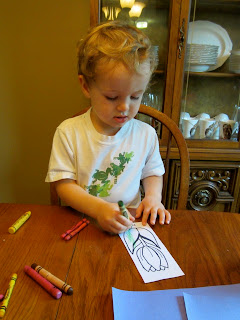This is good on a too-rainy, or too-hot day when kids are getting a little antsy. :-)
Gather materials:
- Glasses (Glasses with a stem are best for the sound, but I doubt you'll want to break out your fine crystal for your preschooler to play with... So, tall glasses will work well too.)
- Water in differing amounts per glass (test out the sound of each to make sure you can hear differences in pitch)
- Metal spoons
- Optional - food coloring for added fun.
Gather kiddos to table. Mine saw me putting out glasses of water and immediately came to see what was going on.
Talk about sound being made by vibration. Demonstrate that tapping a glass (around the rim is best for the most resonance) makes the glass vibrate. The more glass available to vibrate (i.e. less water) the higher the pitch (sound), and the less glass available to vibrate (i.e. more water) produces a lower sound.
Demonstrate the different pitches and how to *gently* tap the glass.
(If you wanted to add food coloring to the different glasses, that's great too... we did a few)
"Oooooooohhh......"
Let kid/s give it a try and make their own combinations of sounds.
Talk about which ones are high-pitched and low-pitched and the in-betweens and why.
Especially with my boys, I had to keep an ear on their "gentle" tapping, but they kept at this for a while on their own and seemed to enjoy it a lot. Yay!
J had the most fun playing this one that sounded like a fire engine bell:
Have fun!



























































